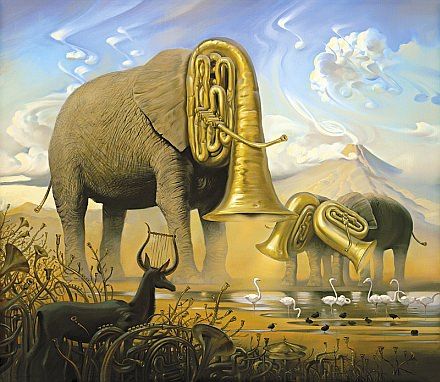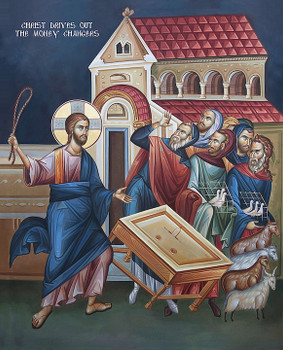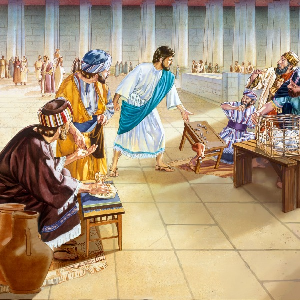Skwim
Veteran Member
The cleansing of the Temple narrative tells of Jesus expelling the merchants and the money changers from the Temple, and occurs in all four New Testament gospels.

is a fair representation of the four verses; Jesus attacking a few merchants and money changers. Something one might concede is entirely possible. However, throughout history this
View attachment 23855
is how the incident has been portrayed: Jesus overpowering a whole crowd of cowering merchants and money changers. Not one of them having the presences of mind to strike back or grapple with Jesus, much less having the brains to work together to stop him.
This isn't to say the incident didn't happen as related in the Bible, but only that Christians have no compunctions about exaggerating the event to a ridiculous extreme----I'm not implying all Christians are guilty of the exaggeration, only those who commissioned and created the works, and those who unquestioningly buy into it. One only has to ask himself, "Assuming Jesus didn't posses the power to cloud men's minds like the Shadow or posses the strength of Superman, how reasonable are the depictions above?" Personally, I find the paintings absurd and have to ask why Christians repeatedly find it necessary to exaggerate the event?
Anyone?
.
Matthew 21:12–13
12 And Jesus entered the temple[a] and drove out all who sold and bought in the temple, and he overturned the tables of the money-changers and the seats of those who sold pigeons. 13 He said to them, “It is written, ‘My house shall be called a house of prayer,’ but you make it a den of robbers.”
Mark 11:15–16
15 And they came to Jerusalem. And he entered the temple and began to drive out those who sold and those who bought in the temple, and he overturned the tables of the money-changers and the seats of those who sold pigeons. 16 And he would not allow anyone to carry anything through the temple.
Luke 19:45–46
45 And he entered the temple and began to drive out those who sold, 46 saying to them, “It is written, ‘My house shall be a house of prayer,’ but you have made it a den of robbers.”
John 2:13–15
13 The Passover of the Jews was at hand, and Jesus went up to Jerusalem. 14 In the temple he found those who were selling oxen and sheep and pigeons, and the money-changers sitting there. 15 And making a whip of cords, he drove them all out of the temple, with the sheep and oxen. And he poured out the coins of the money-changers and overturned their tables.
To my mind this illustration12 And Jesus entered the temple[a] and drove out all who sold and bought in the temple, and he overturned the tables of the money-changers and the seats of those who sold pigeons. 13 He said to them, “It is written, ‘My house shall be called a house of prayer,’ but you make it a den of robbers.”
Mark 11:15–16
15 And they came to Jerusalem. And he entered the temple and began to drive out those who sold and those who bought in the temple, and he overturned the tables of the money-changers and the seats of those who sold pigeons. 16 And he would not allow anyone to carry anything through the temple.
Luke 19:45–46
45 And he entered the temple and began to drive out those who sold, 46 saying to them, “It is written, ‘My house shall be a house of prayer,’ but you have made it a den of robbers.”
John 2:13–15
13 The Passover of the Jews was at hand, and Jesus went up to Jerusalem. 14 In the temple he found those who were selling oxen and sheep and pigeons, and the money-changers sitting there. 15 And making a whip of cords, he drove them all out of the temple, with the sheep and oxen. And he poured out the coins of the money-changers and overturned their tables.
View attachment 23855
is how the incident has been portrayed: Jesus overpowering a whole crowd of cowering merchants and money changers. Not one of them having the presences of mind to strike back or grapple with Jesus, much less having the brains to work together to stop him.
This isn't to say the incident didn't happen as related in the Bible, but only that Christians have no compunctions about exaggerating the event to a ridiculous extreme----I'm not implying all Christians are guilty of the exaggeration, only those who commissioned and created the works, and those who unquestioningly buy into it. One only has to ask himself, "Assuming Jesus didn't posses the power to cloud men's minds like the Shadow or posses the strength of Superman, how reasonable are the depictions above?" Personally, I find the paintings absurd and have to ask why Christians repeatedly find it necessary to exaggerate the event?
Anyone?
.
Last edited:



